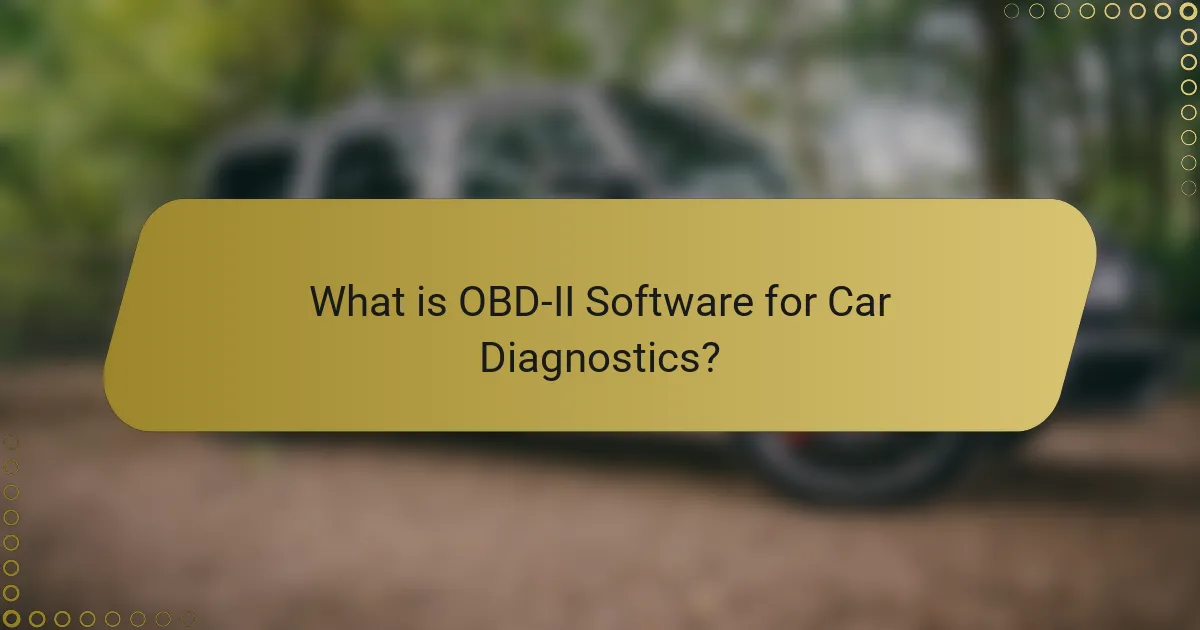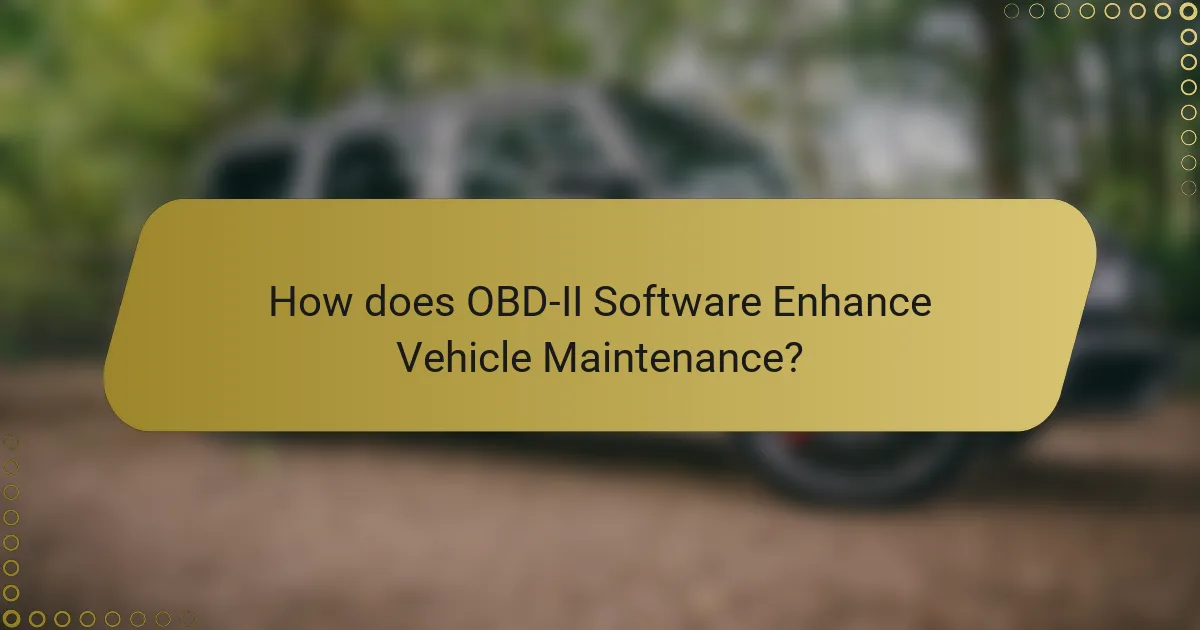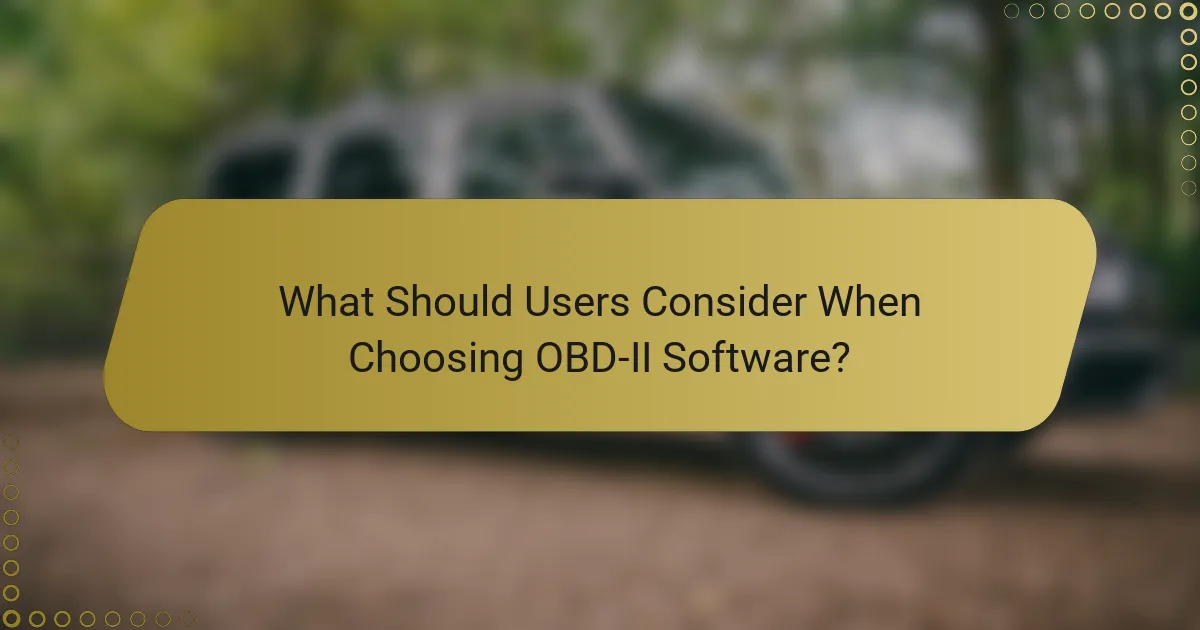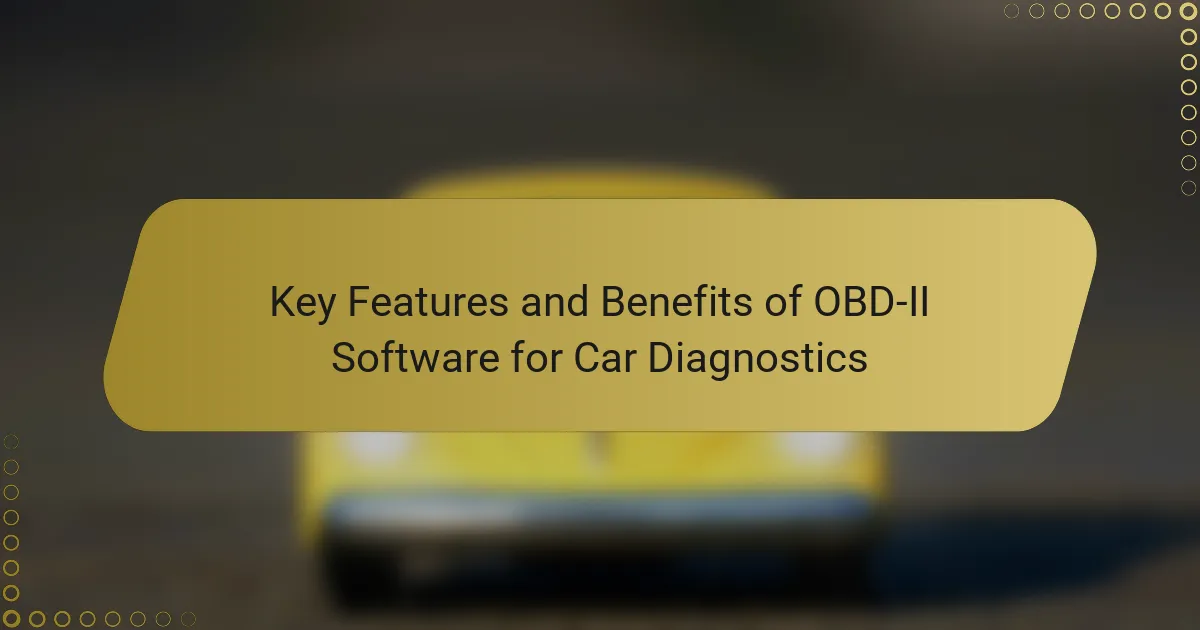OBD-II software is a diagnostic tool that enables communication with a vehicle’s onboard diagnostic system, allowing users to read trouble codes and access real-time data on engine performance and emissions. This software is crucial for both professionals and DIY enthusiasts, facilitating timely vehicle maintenance and efficient troubleshooting. Key features include compatibility with various vehicle makes and models, diagnostic capabilities, and user-friendly interfaces. Regular use of OBD-II software can lead to significant cost savings in repairs and proactive identification of potential issues, making it an essential resource for effective vehicle management. Users should prioritize compatibility, features, ease of use, and support when selecting OBD-II software to enhance their diagnostic experience.

What is OBD-II Software for Car Diagnostics?
OBD-II software for car diagnostics is a tool used to communicate with a vehicle’s onboard diagnostic system. It allows users to read and interpret trouble codes generated by the vehicle’s computer. This software can provide real-time data about engine performance and emissions. It is essential for diagnosing issues and monitoring vehicle health. OBD-II software can be used by both professionals and DIY enthusiasts. It typically connects to the vehicle via a standard OBD-II port. Many versions of this software can also display live sensor data. The use of OBD-II software can lead to more efficient repairs and maintenance.
How does OBD-II software function in vehicle diagnostics?
OBD-II software functions as a diagnostic tool for vehicles by interfacing with the onboard diagnostic system. It retrieves diagnostic trouble codes (DTCs) from the vehicle’s computer. These codes indicate issues within various systems, such as the engine or transmission. The software can also display real-time data from sensors, including engine RPM and vehicle speed. This allows technicians to monitor performance and identify malfunctions. OBD-II software typically connects via a standard port located under the dashboard. It translates the data into a user-friendly format for analysis. The widespread adoption of OBD-II standards ensures compatibility across most vehicles manufactured since 1996. This standardization enhances diagnostic efficiency and accuracy.
What are the key components of OBD-II systems?
The key components of OBD-II systems include the On-Board Diagnostics unit, sensors, and the vehicle’s electronic control unit (ECU). The OBD unit monitors vehicle performance and emissions. Sensors collect data on various parameters like engine temperature and oxygen levels. The ECU processes this data to manage engine functions. Additionally, OBD-II systems utilize diagnostic trouble codes (DTCs) to identify issues. These codes can be retrieved using a scan tool for troubleshooting. The OBD-II connector allows communication between the vehicle and diagnostic equipment. Each of these components plays a crucial role in ensuring efficient vehicle operation and compliance with emissions standards.
How do OBD-II protocols facilitate communication with vehicles?
OBD-II protocols facilitate communication with vehicles by standardizing the data exchange between the vehicle’s onboard computer and diagnostic tools. These protocols enable access to vehicle performance data, trouble codes, and sensor information. OBD-II uses a universal connector, allowing different diagnostic tools to interface with various vehicle makes and models. The protocols define specific message formats and communication methods, ensuring consistent data interpretation. This standardization simplifies troubleshooting and repairs for mechanics. Additionally, OBD-II protocols support real-time data monitoring, enhancing vehicle diagnostics. The effectiveness of OBD-II is evidenced by its widespread adoption since 1996, making it a critical tool in automotive diagnostics.
What are the primary features of OBD-II software?
OBD-II software primarily features diagnostic trouble code (DTC) reading and clearing. It allows users to access real-time data from vehicle sensors. This software also provides freeze frame data, which captures sensor readings at the time of a fault. Additionally, OBD-II software supports emissions monitoring, ensuring compliance with environmental regulations. It often includes live data streaming for performance analysis. Many OBD-II tools offer customizable dashboards for user convenience. The software can also perform readiness tests to check the status of emissions systems. Finally, some OBD-II software includes advanced features like graphing and reporting for in-depth analysis.
What types of data can OBD-II software retrieve from vehicles?
OBD-II software can retrieve various data types from vehicles, including diagnostic trouble codes (DTCs), vehicle speed, engine RPM, coolant temperature, and fuel system status. DTCs indicate specific issues within the vehicle’s systems. Vehicle speed provides real-time information about how fast the vehicle is moving. Engine RPM reflects the engine’s revolutions per minute, essential for performance analysis. Coolant temperature helps monitor engine health by indicating overheating risks. Fuel system status reveals whether the engine is running in open or closed loop, affecting fuel efficiency. Collectively, this data aids in effective diagnostics and maintenance.
How does OBD-II software support real-time monitoring?
OBD-II software supports real-time monitoring by providing continuous access to vehicle data. It communicates with the vehicle’s onboard computer to retrieve information such as engine performance, fuel efficiency, and emissions. This software interprets diagnostic trouble codes (DTCs) in real-time, allowing for immediate identification of issues. Additionally, it can display live data streams, including RPM, coolant temperature, and vehicle speed. This capability enables mechanics and vehicle owners to make informed decisions quickly. Real-time monitoring enhances vehicle maintenance and can prevent serious mechanical failures by alerting users to potential problems as they arise.
What benefits does OBD-II software provide to vehicle owners?
OBD-II software provides vehicle owners with essential diagnostic capabilities. It allows users to read and clear trouble codes from the vehicle’s onboard computer. This function helps identify issues before they escalate into costly repairs. Additionally, OBD-II software can display real-time data from various sensors. This includes information on engine performance, fuel efficiency, and emissions. By monitoring these metrics, owners can optimize vehicle maintenance. Furthermore, the software often includes features for vehicle performance tuning. This can enhance driving experience and efficiency. Overall, OBD-II software empowers owners with valuable insights into their vehicle’s health and performance.
How can OBD-II software help in diagnosing vehicle issues?
OBD-II software aids in diagnosing vehicle issues by reading diagnostic trouble codes (DTCs) from the vehicle’s onboard computer. This software connects to the vehicle’s OBD-II port, enabling communication with the engine control unit (ECU). It retrieves real-time data about engine performance and various system statuses. The software can identify specific malfunctions by interpreting the DTCs, which are standardized codes recognized across different vehicle manufacturers. This process allows technicians to pinpoint problems quickly, reducing diagnostic time. Additionally, OBD-II software often provides live data streams, enabling users to monitor parameters like fuel efficiency and engine temperature. This real-time monitoring helps in understanding vehicle behavior under different conditions. The comprehensive data analysis offered by OBD-II software enhances repair accuracy and efficiency, ultimately leading to better vehicle maintenance.
What cost savings can be achieved using OBD-II software?
OBD-II software can achieve significant cost savings in vehicle diagnostics and maintenance. It reduces the need for expensive diagnostic tools by providing real-time data access. This software allows for quicker identification of issues, minimizing labor costs associated with troubleshooting. By addressing problems early, it helps prevent costly repairs down the line. Studies show that using OBD-II can decrease vehicle downtime, leading to savings in operational costs. Additionally, it enhances fuel efficiency by monitoring engine performance, which can lower fuel expenses. Overall, OBD-II software streamlines the diagnostic process and contributes to long-term savings for vehicle owners and fleets.

How does OBD-II Software Enhance Vehicle Maintenance?
OBD-II software enhances vehicle maintenance by providing real-time diagnostic information. It allows mechanics and vehicle owners to read trouble codes and monitor vehicle performance. This software can identify issues before they become serious problems. It provides data on engine performance, emissions, and other vital systems. Regular use of OBD-II software can lead to timely maintenance and repairs. Studies show that proactive diagnostics can reduce repair costs by up to 30%. Additionally, it supports efficient troubleshooting, saving time and resources during maintenance. Overall, OBD-II software is a critical tool for effective vehicle management.
What role does OBD-II software play in preventative maintenance?
OBD-II software plays a crucial role in preventative maintenance by providing real-time data on vehicle performance. It monitors various systems, including engine, transmission, and emissions. This monitoring helps identify potential issues before they escalate into major problems. For instance, it can detect abnormal sensor readings or malfunctioning components. Early detection allows for timely repairs, reducing the risk of breakdowns. Additionally, OBD-II software can generate diagnostic trouble codes (DTCs) that guide technicians in troubleshooting. This targeted approach to maintenance enhances vehicle reliability and longevity. Overall, OBD-II software contributes significantly to effective preventative maintenance strategies.
How can OBD-II software assist in tracking vehicle performance?
OBD-II software assists in tracking vehicle performance by providing real-time data on various engine parameters. It monitors metrics such as speed, RPM, fuel efficiency, and engine temperature. This software accesses the vehicle’s onboard diagnostics system through a standardized protocol. It retrieves diagnostic trouble codes (DTCs) that indicate performance issues. Real-time data helps identify inefficiencies and potential problems early. Enhanced tracking can lead to improved fuel economy and reduced emissions. Many OBD-II applications also offer historical data analysis for performance trends. These capabilities make OBD-II software essential for effective vehicle maintenance and performance optimization.
What insights can be gained from OBD-II software for long-term vehicle care?
OBD-II software provides valuable insights for long-term vehicle care. It offers real-time data on engine performance and diagnostics. This software can identify potential issues before they escalate into costly repairs. It tracks vehicle health metrics such as fuel efficiency and emissions levels. Regular monitoring can help maintain optimal performance and extend vehicle lifespan. OBD-II systems can also store historical data, allowing for trend analysis over time. This information aids in scheduling preventative maintenance effectively. By using OBD-II software, vehicle owners can make informed decisions about repairs and maintenance needs.
What are the common challenges faced when using OBD-II software?
Common challenges faced when using OBD-II software include compatibility issues, user interface difficulties, and data interpretation hurdles. Compatibility issues arise when the software does not support specific vehicle makes or models. Many vehicles have unique protocols that some software cannot access. User interface difficulties can make navigation complex for users, especially those without technical backgrounds. These interfaces may lack intuitive design, leading to confusion. Data interpretation hurdles occur when users struggle to understand diagnostic trouble codes and their meanings. Misinterpretation can lead to incorrect conclusions about vehicle issues. Additionally, software updates may be required frequently to maintain accuracy, which can be a burden for users. These challenges highlight the need for user-friendly and comprehensive OBD-II software solutions.
How can users overcome compatibility issues with OBD-II software?
Users can overcome compatibility issues with OBD-II software by ensuring they use the correct software version for their vehicle. Compatibility often depends on the vehicle’s make, model, and year. Users should verify that their OBD-II software supports their specific vehicle’s protocols. Researching software reviews can provide insights into compatibility experiences from other users. Additionally, updating the software to the latest version can resolve known issues. Users should also check for firmware updates for their OBD-II interface. Connecting with manufacturer support can provide tailored advice for specific compatibility concerns.
What troubleshooting steps can be taken when OBD-II software fails to connect?
Ensure the OBD-II connector is securely plugged into the vehicle’s diagnostic port. Check the vehicle’s ignition is in the “On” position without starting the engine. Verify that the OBD-II software is compatible with the vehicle’s make and model. Restart the software and attempt to reconnect. Inspect the vehicle’s fuses related to the OBD-II system for any blown fuses. Update the OBD-II software to the latest version available. Try using a different OBD-II cable or adapter to eliminate hardware issues. If problems persist, consult the software’s user manual for specific troubleshooting guidance.

What Should Users Consider When Choosing OBD-II Software?
Users should consider compatibility, features, ease of use, and support when choosing OBD-II software. Compatibility ensures the software works with the specific vehicle make and model. Features should include diagnostic capabilities, data logging, and real-time monitoring. Ease of use affects how quickly users can navigate the interface and access information. Adequate support options, such as tutorials and customer service, enhance the user experience. Research indicates that 70% of users prioritize compatibility when selecting automotive software. Thus, ensuring these factors are met can lead to more effective diagnostics and vehicle maintenance.
What features should be prioritized when selecting OBD-II software?
Prioritized features when selecting OBD-II software include compatibility, user interface, and diagnostic capabilities. Compatibility ensures the software works with various vehicle makes and models. A user-friendly interface enhances ease of use for both professionals and DIY enthusiasts. Robust diagnostic capabilities allow for comprehensive scanning of trouble codes and real-time data monitoring. Additionally, features like live data streaming, freeze frame data, and readiness status are essential for effective diagnostics. Support for advanced functions such as ABS and airbag diagnostics can further enhance the software’s utility. Regular updates are crucial for maintaining compatibility with newer vehicles and technologies.
How does user interface impact the effectiveness of OBD-II software?
The user interface significantly impacts the effectiveness of OBD-II software. A well-designed interface enhances user experience and improves diagnostic accuracy. Clear navigation allows users to access features quickly. Intuitive layouts reduce the learning curve for new users. Visual representations of data facilitate better understanding of diagnostic information. Customizable options enable users to tailor the interface to their needs. Studies show that user-friendly software can lead to quicker troubleshooting and resolution times. Effective user interfaces contribute to higher user satisfaction and increased adoption rates of OBD-II software.
What pricing models are available for OBD-II software?
OBD-II software typically offers several pricing models. Common models include one-time purchase, subscription-based, and freemium options.
One-time purchase models require a single payment for lifetime access. Subscription-based models charge users monthly or annually for ongoing access and updates. Freemium models provide basic features for free, with premium features available for purchase.
These pricing structures cater to different user needs and preferences. For example, users who require consistent updates may prefer subscription models. In contrast, occasional users might opt for a one-time purchase.
What are the best practices for utilizing OBD-II software effectively?
To utilize OBD-II software effectively, ensure proper connection to the vehicle’s OBD-II port. This port is usually located under the dashboard near the driver’s seat. Use compatible software that matches the vehicle’s make and model for accurate diagnostics. Regularly update the software to access the latest features and fixes. Familiarize yourself with the software interface to navigate easily through menus and options. Utilize diagnostic trouble codes (DTCs) to identify issues accurately. Always refer to manufacturer specifications for interpreting codes and recommended repairs. Create a log of diagnostic reports for future reference and troubleshooting. Following these practices enhances the effectiveness of OBD-II software in diagnosing vehicle issues.
How can users ensure they are maximizing the benefits of OBD-II software?
Users can maximize the benefits of OBD-II software by regularly updating it. Updates often include new diagnostic features and bug fixes. Users should also familiarize themselves with the software’s interface and functionalities. Understanding the available tools enhances diagnostic accuracy. Additionally, users should connect the software to their vehicle’s OBD-II port correctly. Proper connection ensures accurate data retrieval. Regularly reviewing diagnostic reports helps users identify recurring issues. This proactive approach aids in timely vehicle maintenance. Engaging with online forums can provide valuable user experiences and tips. This community support can enhance the overall use of the software.
What common mistakes should be avoided when using OBD-II software?
Common mistakes to avoid when using OBD-II software include not reading the manual beforehand. Users often overlook this, which can lead to improper usage. Failing to update the software regularly is another mistake. Outdated software may not recognize newer vehicle codes. Users should also avoid connecting the software to a vehicle with the ignition off. This can prevent the software from functioning correctly. Another common mistake is ignoring error codes without proper diagnosis. This can lead to misinformed repairs. Additionally, not checking compatibility with the vehicle model can result in connection issues. Lastly, neglecting to save or document diagnostic results can hinder future troubleshooting.
OBD-II software for car diagnostics is a crucial tool that interfaces with a vehicle’s onboard diagnostic system to read trouble codes and monitor real-time data related to engine performance and emissions. This software enhances vehicle maintenance by enabling users to identify issues early, optimize performance, and ensure compliance with emissions standards. Key features include diagnostic trouble code reading, real-time data access, and customizable dashboards, while benefits encompass cost savings through efficient diagnostics and preventative maintenance. The article will explore the functionality, primary features, and advantages of OBD-II software, along with considerations for selecting the right tool for effective vehicle management.
